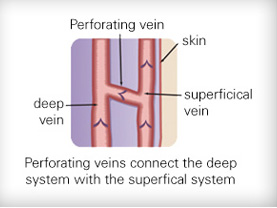| Perforator Veins |
| |
| What are Perforator Veins? |
 |
| |
Perforator veins serve as connections between the two networks of veins in the extremities, the superficial and the deep venous system. Perforators connect the two parallel venous systems, somewhat like the cross-bars of a ladder connect the side rails. They normally drain blood from the superficial veins to the deep veins as part of the process of returning oxygen-depleted blood to the heart.
Perforator veins have one-way valves designed to prevent backflow of blood down towards the superficial veins. When these valves no longer function properly and reflux occurs, the buildup of blood and pressure can cause not only the superficial veins but the perforators themselves to become incompetent. Perforator veins in the lower leg and ankle are particularly vulnerable to distention and incompetence. The resultant circulatory problems create an increased likelihood of edema, skin discoloration, dermatitis and skin ulcers in the area.
Like primary superficial veins that become varicose, perforator veins can be treated. |
|
|









